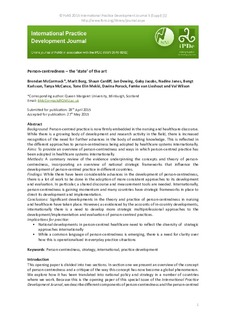| dc.contributor.author | McCormack, Brendan | |
| dc.contributor.author | Borg, Marit | |
| dc.contributor.author | Cardiff, Shaun | |
| dc.contributor.author | Dewing, Jan | |
| dc.contributor.author | Jacobs, Gaby | |
| dc.contributor.author | Janes, Nadine | |
| dc.contributor.author | Karlsson, Bengt Eirik | |
| dc.contributor.author | McCance, Tanya | |
| dc.contributor.author | Mekki, Tone Elin | |
| dc.contributor.author | Porock, Davina | |
| dc.contributor.author | Lieshout, Famke van | |
| dc.contributor.author | Wilson, Val | |
| dc.date.accessioned | 2018-07-03T09:05:29Z | |
| dc.date.available | 2018-07-03T09:05:29Z | |
| dc.date.created | 2015-09-11T14:19:47Z | |
| dc.date.issued | 2015 | |
| dc.identifier.citation | International Practice Development Journal. 2015, 5, 1-15. | nb_NO |
| dc.identifier.issn | 2046-9292 | |
| dc.identifier.uri | http://hdl.handle.net/11250/2504118 | |
| dc.description.abstract | While there is a growing body of development and research activity in the field, there is increased recognition of the need for further advances in the body of existing knowledge. This is reflected in the different approaches to person-centredness being adopted by healthcare systems internationally. Aims: To provide an overview of person-centredness and ways in which person-centred practice has been adopted in healthcare systems internationally. Methods: A summary review of the evidence underpinning the concepts and theory of person-centredness, incorporating an overview of national strategic frameworks that influence the development of person-centred practice in different countries. Findings: While there have been considerable advances in the development of person-centredness, there is a lot of work to be done in the adoption of more consistent approaches to its development and evaluation. In particular, a shared discourse and measurement tools are needed. Internationally, person-centredness is gaining momentum and many countries have strategic frameworks in place to direct its development and implementation. Conclusions: Significant developments in the theory and practice of person-centredness in nursing and healthcare have taken place. However, as evidenced by the accounts of in-country developments, internationally there is a need to develop more strategic multiprofessional approaches to the development/implementation and evaluation of person-centred practices. Implications for practice: National developments in person-centred healthcare need to reflect the diversity of strategicapproaches internationally While a common language of person-centredness is emerging | nb_NO |
| dc.language.iso | eng | nb_NO |
| dc.relation.uri | http://www.fons.org/library/journal/volume5-person-centredness-suppl/article1 | |
| dc.rights | Navngivelse-Ikkekommersiell 3.0 Internasjonal | * |
| dc.rights.uri | http://creativecommons.org/licenses/by-nc/3.0/deed.no | * |
| dc.title | Person-centredness – the ‘state’ of the art | nb_NO |
| dc.type | Journal article | nb_NO |
| dc.type | Peer reviewed | nb_NO |
| dc.description.version | publishedVersion | nb_NO |
| dc.rights.holder | © FoNS 2015 International | nb_NO |
| dc.source.pagenumber | 1-15 | nb_NO |
| dc.source.volume | 5 | nb_NO |
| dc.source.journal | International Practice Development Journal | nb_NO |
| dc.identifier.cristin | 1263588 | |
| cristin.unitcode | 222,56,1,0 | |
| cristin.unitcode | 222,56,3,0 | |
| cristin.unitname | Institutt for sykepleie- og helsevitenskap | |
| cristin.unitname | Institutt for helse-, sosial- og velferdsfag | |
| cristin.ispublished | true | |
| cristin.fulltext | original | |
| cristin.qualitycode | 1 | |

